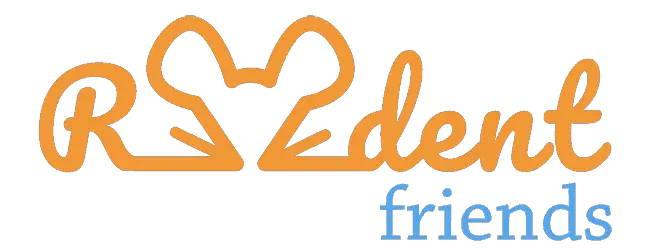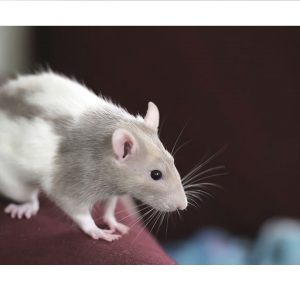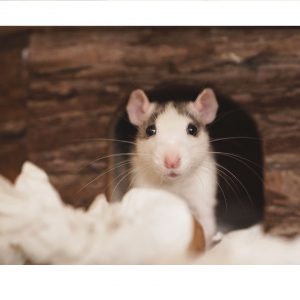Pet rat owners usually think itching or scratching is unusual, but it’s not. Doing so in rats is common.
However, if this prolongs and you observe marks on your pet rat, pay attention. Your pet rat might have caught some kind of parasite or be allergic to something in their cage or food, for example.
If you are worried about the frequent itching and scratching of your pet rat, here is a complete guide that will educate you about everything you need to know.
Why is my rat scratching a lot?
Scratching or itching in your rat can be due to multiple reasons. Some of these are normal while in the case of others, your pet requires your help to get rid of itchiness.
In some cases, you may need to consult your veterinarian. Below are some of the most common reasons why your rat might be scratching.
External Parasites
External parasites are the biggest reason for itchiness in many animal species, including your pet rat. The three external parasites which could be problematic for your pet rat include mites, lice, and fleas.
All these parasites can carry transmittable diseases or even other internal parasites. It is important that you take care of these little bugs. before your pet rat is infested by them.
The main distinguishing factor among the three is their length. The length of mites in rats usually ranges between 0.75-1.44 mm, whereas in lice is ½-1 ½ mm, and for fleas is 2mm.
Let’s discuss each of these parasites in detail so you can identify each of them if needed:
Lice
Itching or scratching in your rat due to lice is common. Rat lice are spindle-shaped and have a yellow or tan color with a red or brown spotted middle part.
Being narrower and not much longer makes it difficult to catch them. If you wish to spot and remove lice from your rat, using a magnifying glass makes it easy. It will also aid in spotting eggs on the hair which seem like small silver droplets.
If you think your rat has lice then you should check the back, neck, and shoulders because these spots are the most infested as your rat finds it difficult to reach these spots.
Lice are parasites and they suck blood from their host which can result in anemia. They lay nits on hair, and if your rat is hairless then lice can’t reproduce. Lice are specific to animal species and humans. This means they are different, depending on the species.
So if you are in contact with your rat, you don’t need to be worried as lice are not interested in you.
The life span of lice is no longer than 35 days.
Mites
Mites are classified into three categories:
The fur rat mite (Radfordia Ensifera) is the most common mite. It causes severe itching which paves the way to scabs that are likely to be seen on the face, shoulders, and neck of a rat.
Symptoms do not appear in all cases of mite infestation in rats. It is quite possible that your pet rat is suffering from mite infestation without showing visible signs.
Unfortunately, if your pet rat dies without any apparent disease, then there is a probability of fur mites, which can be observed by leaving the body after some time.
You will see small white pinpricks on the tips of your rat’s hair and these are mites that crawl to the fur of your rat.
Being specie specific these mites only live on rats and can’t affect humans or other animal species.
Fur rat mites are capable of living above or beneath the skin. They are small in size and can be observed with a microscope or skin scraper.
If you don’t have these, press a see-through tape on the fur to see fur mites.
In case your pet rat is diagnosed with mite infestation, it is necessary to take measures. Ask a professional. Your pet rat’s vet will know what to do!
Fleas
Among the three ectoparasites mentioned earlier, fleas are the least problematic for rats.
Cats and dogs are the primary hosts of fleas, rats are the secondary ones. If you and your pet rat are in a house infested with fleas, this means your other pets have them.
Scabs will appear on the biting areas of fleas.
You can observe the fleas’ droppings if you don’t see them on your rat.

Allergy
Frequent itching or scratching in your pet rat can be due to some substances or chemicals which act as allergens for your rat and cause allergy.
Below are common allergens that can cause a sensation of itching due to allergy, so let’s discuss them one by one:
Dairy products allergy
Rats are allergic to dairy products such as yogurt. Even a few drops are enough to initiate this type of allergy.
Your pet rat is allergic to compounds such as maltose, lactose, etc. Even though some pet rats can adapt themselves to dairy, they are a common allergen.
If you do notice a reaction, either itchy skin or changes in their droppings consistency, you should avoid giving them dairy treats.
There are many healthy treats you can give your pet rat. Alternatively, you can even find lactose-free or vegetable products and use those as a replacement.
Litter allergy
Sensitivity toward litter in rats is scarce except for shavings of cedar or pine.
So, if you are using any of them for the bedding of your rat you should change it because it contains an aromatic component called phenol.
It is toxic for your rat and may cause itching. Use rat favorable bedding which includes paper pellet and cloth bedding etc.
Personally, I’m a fan of the So Phresh Paper Pellets. It’s got no perfumed scent and is made out of paper. It will not only keep your pet rat’s litter cleaner for longer, but it’s also safer for your pet rats.
The same goes for their bedding, throughout their cage. Paper-based bedding is a nice option as well and I always like to recommend the Carefresh Dust-Free Natural Paper Bedding. Once again it keeps the cage cleaner for longer and it’s easy to clean it up, whenever needed!
Food allergy
If the scratching or itching even after changing litter or avoiding dairy products continues, then you are left with testing the food allergens.
To do so, give a test diet to your rat, for instance, mix raw millet with brown cooked rice and add 1 teaspoon Nutri-Cal every day.
Continue to do so for a week or more and if you find good results then start adding another food one by one in the meal to watch out if this pops out itching or not.
When you have identified that specific food that your pet rat is allergic to, avoid it, and put them on a routine diet.
Peanut is a common food allergen, for example, so abstain from using substances that contain any form of peanuts.
Symptoms
If your pet rat is suffering from abnormal scratching and itchiness, it may show one or more of the below-mentioned signs:
- Skin inflammation
- Biting the fur due to fur mites
- Scabbed shoulder, neck, and face
- Skin scratched due to heavy mites infestation
- Hair loss because of lice or tropical mites infestation
- Rashes on the skin and coughing due to allergens (allergy)
How Do I Get My Pet Rat To Stop Scratching?
The following measures can help you stop a scratchy and itchy pet rat:
Give a bath to your pet rat
Giving a bath to your pet rat is an efficient way to keep your rat away from mites and other parasites.
Before giving a bath to your rat make sure the whole process is safe for your pet. Check the temperature of the water, and get everything you’d need near you including soap and a dry towel.
You can give a bath to your rat either by putting him in a pan and then applying soap or you can put your rat in a pan full of soap water.

Thorough cleaning of the cage
Clean the cage of your pet rat regularly.
Wash the cage, toys, water cups, and feed plates with water and detergent. Eradicate the contaminated food and bedding.
Put the other commodities in a freezing area or in some low-temperature compartment for around 24 hours, which will help in killing any insect hiding inside.
If the weather is cold, then you can put the cage outside for this freezing purpose as well. The next day, put the cage accessories back but make sure that no detergent is left.
Kill the parasite
Immediately kill the parasite if you spot it whether it’s a mite, lice, or flea.
But be careful about killing mites especially don’t rush because if you pluck the mite out, only its body will come out and the head will remain in the skin. This could be more dangerous for your pet rat.
Generally, it’s good to ask for the veterinarian’s advice for further examination and proper treatment.
Especially if this is happening for the first time and you have no experience in getting rid of these bugs!
Having some assistance and guidance is always helpful.
Consulting your veterinarian
If you do notice your pet rat keeps scratching itself, ask for veterinarian advice.
The vet will check all the possible reasons behind this and prescribe you the best possible medication for your rat.
They will also tell you the best way to clean your pet rat’s environment and how to keep it from happening again.
Parasite Treatment
Many viable measures can be taken to treat parasite infestation in rats. Let’s discuss some of them.
Remember that is only informational, and you must first consult your veterinarian before using anything!
Spray or powder
If you are thinking of using spray or powder to treat the infestation, it may not work properly because rats are reluctant to spray.
Also, you won’t be able to stop your rat from chemical intake through inhaling and licking.
Moxidectin
The best treatment is using moxidectin for rat fur mites or mange mites and lice. If your pet rat’s fur is yellow, here are the reasons.
Pet vaccination stores or centers may or may not have this. If you give them your rat’s prescription, they can order especially for you or you can also purchase online.
Moxidectin remains in the body for long enough and only one dose is enough for lice and mites.
It will also aid in killing roundworms. The effectiveness of moxidectin on tropical mites is not evident. So moxidectin can be referred to as a partial parasite killer.
Selamectin
Selamectin (revolution) is a complete external parasite treatment, which means it can also treat tropical rat mites.
Revolution is the on-target product, a fluid applied on the skin in between the blades of the shoulder. It’s only available to vets or a person with a prescription.
Divert the attention of your rat after applying to avoid licking, eating, and scratching the liquid. Just do it for five minutes because the liquid will driest.
A single dose is sufficient to treat your rat.
FAQs
Can I give a bath to my itching pet rat?
Yes, you can. You can give them a bath and see if that helps them.
It’s good to get them used to water first, before giving them a full bath. Pet rats can learn to love and have fun in the water, while others might not take it so well.
Either you can put your rat in a pan full of water and apply soap, or dip him in a soap water pan, for example. Here’s a small guide to getting your pet rat used to the water.
Can humans get lice from their pet rats?
No! Lice are species-specific, so if you interact with your rat or any other animal, their lice can’t be transmitted to you.
Don’t be reluctant when you are in contact with rats.
How do I know if my rat has mites?
The skin inflammation and scratches on the skin providing the infectious environment are clear indications of mites.
Pressing a transparent tape against your pet rat will give the assurance of having mites, but this method is not 100 % accurate.
Final words
Itching or scratching in pet rats is common, but if it continues for long, then it might be an indication of something serious.
Don’t confuse this with grooming though, you can read more about grooming in pet rats here!
Ectoparasites and allergic reactions can be potential reasons for excessive itching in rats.
There are various methods for the elimination of these parasites. You should consult your veterinarian for proper diagnosis and treatment of the problem.






